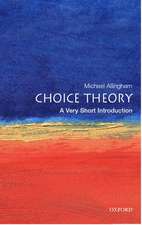Silverman’s Game: A Special Class of Two-Person Zero-Sum Games: Lecture Notes in Economics and Mathematical Systems, cartea 424
Autor Gerald A. Heuer, Ulrike Leopold-Wildburgeren Limba Engleză Paperback – 20 iun 1995
Din seria Lecture Notes in Economics and Mathematical Systems
-
 Preț: 360.02 lei
Preț: 360.02 lei -
 Preț: 383.93 lei
Preț: 383.93 lei - 15%
 Preț: 693.39 lei
Preț: 693.39 lei -
 Preț: 384.09 lei
Preț: 384.09 lei -
 Preț: 380.07 lei
Preț: 380.07 lei -
 Preț: 446.26 lei
Preț: 446.26 lei -
 Preț: 497.37 lei
Preț: 497.37 lei -
 Preț: 380.84 lei
Preț: 380.84 lei -
 Preț: 384.86 lei
Preț: 384.86 lei -
 Preț: 378.34 lei
Preț: 378.34 lei -
 Preț: 399.67 lei
Preț: 399.67 lei - 20%
 Preț: 360.93 lei
Preț: 360.93 lei - 15%
 Preț: 643.16 lei
Preț: 643.16 lei -
 Preț: 379.09 lei
Preț: 379.09 lei -
 Preț: 404.76 lei
Preț: 404.76 lei -
 Preț: 385.62 lei
Preț: 385.62 lei - 15%
 Preț: 644.49 lei
Preț: 644.49 lei -
 Preț: 379.09 lei
Preț: 379.09 lei -
 Preț: 345.50 lei
Preț: 345.50 lei -
 Preț: 425.80 lei
Preț: 425.80 lei -
 Preț: 378.34 lei
Preț: 378.34 lei - 18%
 Preț: 775.65 lei
Preț: 775.65 lei -
 Preț: 392.60 lei
Preț: 392.60 lei -
 Preț: 401.61 lei
Preț: 401.61 lei - 15%
 Preț: 646.43 lei
Preț: 646.43 lei -
 Preț: 382.18 lei
Preț: 382.18 lei -
 Preț: 378.34 lei
Preț: 378.34 lei - 15%
 Preț: 637.59 lei
Preț: 637.59 lei - 15%
 Preț: 647.27 lei
Preț: 647.27 lei -
 Preț: 377.73 lei
Preț: 377.73 lei -
 Preț: 447.84 lei
Preț: 447.84 lei - 15%
 Preț: 644.49 lei
Preț: 644.49 lei -
 Preț: 386.00 lei
Preț: 386.00 lei - 15%
 Preț: 654.43 lei
Preț: 654.43 lei -
 Preț: 415.02 lei
Preț: 415.02 lei -
 Preț: 411.54 lei
Preț: 411.54 lei -
 Preț: 398.92 lei
Preț: 398.92 lei -
 Preț: 398.92 lei
Preț: 398.92 lei -
 Preț: 392.75 lei
Preț: 392.75 lei - 15%
 Preț: 635.47 lei
Preț: 635.47 lei - 20%
 Preț: 653.56 lei
Preț: 653.56 lei -
 Preț: 379.86 lei
Preț: 379.86 lei -
 Preț: 495.46 lei
Preț: 495.46 lei -
 Preț: 447.99 lei
Preț: 447.99 lei -
 Preț: 378.71 lei
Preț: 378.71 lei - 15%
 Preț: 637.13 lei
Preț: 637.13 lei -
 Preț: 385.84 lei
Preț: 385.84 lei -
 Preț: 378.54 lei
Preț: 378.54 lei - 15%
 Preț: 666.55 lei
Preț: 666.55 lei
Preț: 388.34 lei
Nou
Puncte Express: 583
Preț estimativ în valută:
74.32€ • 77.30$ • 61.35£
74.32€ • 77.30$ • 61.35£
Carte tipărită la comandă
Livrare economică 14-28 aprilie
Preluare comenzi: 021 569.72.76
Specificații
ISBN-13: 9783540592327
ISBN-10: 3540592326
Pagini: 300
Ilustrații: X, 283 p.
Dimensiuni: 155 x 235 x 16 mm
Greutate: 0.42 kg
Ediția:Softcover reprint of the original 1st ed. 1995
Editura: Springer Berlin, Heidelberg
Colecția Springer
Seria Lecture Notes in Economics and Mathematical Systems
Locul publicării:Berlin, Heidelberg, Germany
ISBN-10: 3540592326
Pagini: 300
Ilustrații: X, 283 p.
Dimensiuni: 155 x 235 x 16 mm
Greutate: 0.42 kg
Ediția:Softcover reprint of the original 1st ed. 1995
Editura: Springer Berlin, Heidelberg
Colecția Springer
Seria Lecture Notes in Economics and Mathematical Systems
Locul publicării:Berlin, Heidelberg, Germany
Public țintă
ResearchCuprins
1. Introduction.- Survey of prior work.- The payoff function and expected payoffs.- The sequences {pk} and {vk}.- The sequences {Vk} and {Uk}.- Equivalent variations.- 2. Silverman’s game on intervals: preliminaries.- The key mixed strategies.- 3. Intervals with equal left endpoints or equal right endpoints.- The regions LAn, and equal right endpoints.- Case 1. [(1, B)] × [(1, B)].- Case 2. [(1, B)] × [(1, D)],1 < B < D.- Case 3. [(1, B)] × [(A, B)], 1 < A < B.- 4. Intervals with no common endpoints.- Case 4. [(1, B)] × [(A, D)], 1 < A < B < D.- Case 5. [(1, D)] × [(A, B)], 1 < A < B < D.- Case 6. [(1, B)] × [(A, D)], 1 < B ? A < D.- Appendix. Multisimilar distributions.- 5. Reduction by dominance.- Type A dominance.- Type B dominance.- Type C dominance.- Type D dominance.- Semi-reduced games.- 6. The further reduction of semi-reduced games.- Games with |M| = 1. (Reduction to 2 × 2.).- Games with M = 0 which reduce to odd order.- Games with M = 0 which reduce to even order.- 7. The symmetric discrete game.- The symmetric game with v ? 1.- The symmetric game with v < v(n).- 8. The disjoint discrete game.- The disjoint game with v ? 1.- The disjoint game with v < 1.- 9. Irreducibility and solutions of the odd-order reduced games.- The reduced game matrix A and the associated matrix B.- The polynomial sequences.- The odd-order game of type (i).- The odd-order game of type (ii).- The odd-order game of type (iii).- The odd-order game of type (iv).- 10. Irreducibility and solutions of the even-order reduced games.- The reduced game matrix A and the associated matrix B.- Further polynomial identities.- The even-order game of type (i).- The even-order games of types (ii) and (iii).- The even-order game of type (iv).- 11. Explicit solutions.- The game onintervals.- The symmetric discrete game.- The disjoint discrete game.- The reduced discrete game.- Semi-reduced balanced discrete games with no changes of sign on the diagonal.- Maximally eccentric games.- References.


















